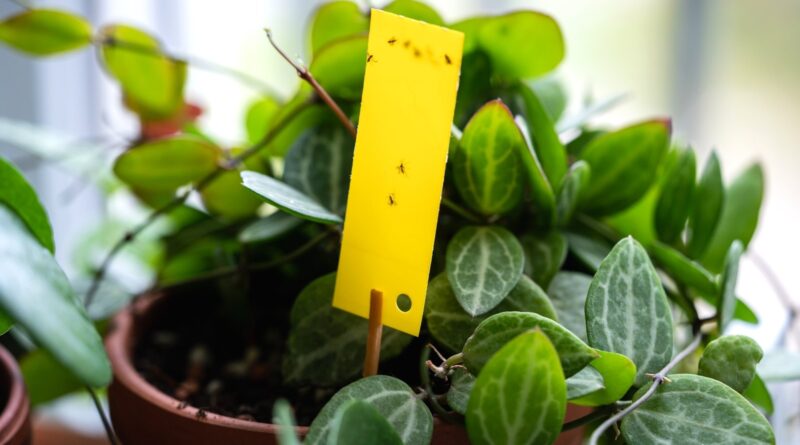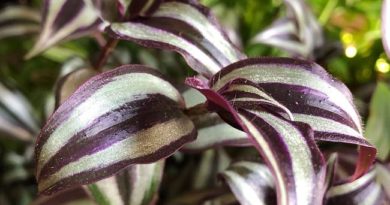How To Use Sticky Traps To Get Rid of Houseplant Pests
Houseplant pests are always a nuisance, but I find the flying ones particularly irritating. This isn’t just because they create a cloud around your precious plants and attack them, but also because they tend to spread throughout our homes, too.
If you have a flying pest problem, sticky traps will come to your rescue. These adhesive traps lure and catch flying pests around your houseplants, killing them and limiting their reproduction rate. They are also easy to use, following this easy guide.
What Are Sticky Traps?

These traps are adhesive surfaces for luring and trapping flying pests, eventually killing them. You can use them both indoors and out, but they are particularly effective in enclosed spaces like indoor gardens.
Sticky traps draw flying pests to the surface with their bright color (usually yellow). Thanks to the sticky glue covering the paper, the pests are trapped once they land on the surface and can’t escape. This also stops the adults from reproducing, limiting spread. The stickiness fades with time due to pest coverage and dust, so replace them every few weeks to continue to catch pesky bugs.
Since they are placed around the soil or hung above plants, they only really work on flying pests. They won’t treat all houseplant pest problems but will catch the adults of any flying bugs nearby. They also won’t catch every single bug or their eggs, so use follow-up treatments with targeted products to resolve the issue completely.
You can use sticky traps for more than just infestation treatment – you can also use them to monitor for issues and identify them before they get out of hand. Regularly using them will help you notice flying pests before they take over your home, making them much easier to deal with.
Which Pests Do They Catch?

Yellow sticky traps are primarily used to target one of the most annoying houseplant pests – fungus gnats. These are the tiny flying bugs that hover around your houseplants and the rest of your home if they get out of hand. Although they burrow into the soil to lay eggs, adults that hatch and fly out of the soil can be caught this way.
These traps can also be useful against other houseplant pests, including whiteflies and thrips. As long as the bugs can fly and are attracted to the color yellow, they will probably end up in your traps. Hanging versions are also effective against flies, which may not be an issue for your houseplants but also become a nuisance around the home.
How To Use

If you notice pests hovering around your houseplants, it’s time to install some sticky traps. The process is incredibly simple, and the product you purchase will usually come with instructions on installation.
Type
The most common houseplant traps have sticks buried directly into the soil, allowing the sticky part to remain just above the soil line. These are ideal for catching fungus gnats that are attracted to moisture in the soil.
Hanging traps should be hung at the level of the pest problem to catch as many bugs as possible. Keep them away from direct contact with leaves, as the sticky surfaces can trap more than just bugs.
Most products come with an adhesive covering that you need to peel off to reveal the glue on either one side or both. Peel carefully to avoid getting any of the glue on your fingers, then bury the trap into the soil so it is sitting upright. You can also lay the trap flat on the soil to catch even more bugs. Leave only one adhesive side sticky and flip the trap over once it loses its stickiness.
How Many Do You Need?
Depending on the trap size and your plant, you’ll probably need to use more than one trap for maximum effectiveness. I would opt for two on opposite sides in smaller containers, adding a few more for large pots. The more bugs you can catch, the better.
Keep a close eye on the traps, as they will become less sticky over time. If you notice dust collecting on the traps, leaving them ineffective, replace them with new traps. It’s best to change out the traps (or flip them over when lying flat) every couple of weeks. Most products come with several traps in a pack for continued treatment.
Follow Up Treatment

While these traps are great for identifying problems and catching bugs, experts warn that they won’t get rid of an infestation completely. They only catch the bugs in the flying stage, ignoring any eggs or nymphs feeding on plants elsewhere. They also don’t guarantee the removal of all the adults, as you can’t be sure each one will fly into the trap.
If you want to remove the pests completely, start by identifying which houseplant bug you’re dealing with. From here, you can apply a targeted treatment for those specific pests, like insecticidal soap or neem oil. For soil-borne pests like gnats, repotting and replacing the soil can also help limit infestations.
Continue treating your plants until no new pests appear on them. Afterward, you can continue to use the traps around your houseplants for signs of new infestations. Also, use other preventative measures like watering carefully to avoid the soggy conditions that attract bugs and avoiding overcrowding to stop the spread of early infestations.
Final Thoughts
Sticky traps are effective tools for monitoring and catching flying houseplant pests when they are used correctly. However, following up with targeted treatments is important if you want to remove the pests for good.




